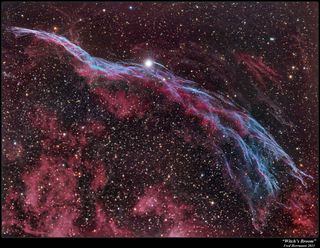
A pair of spooky and spectacular celestial sights are showcased in two new photos, just in time for Halloween.
One new image, from the University of Arizona's Mt. Lemmon SkyCenter (MLSC), depicts the dazzling Wizard Nebula, which surrounds an open star cluster 8,000 light-years from Earth called NGC 7380.
"In this orientation, I doubt you will see the wizard, but there is still something very mysterious about the sculpted ridges of gas and dust that give this nebula a Halloween feel (I see bat-like appendages)," Adam Block, manager of public observing programs at MLSC, told SPACE.com via email. [The Spookiest Nebula Photos of All Time (Gallery)]
The Wizard Nebula lies in the direction of the constellation Cepheus and can be seen with a small telescope.
"The active star-forming region spans about 100 light-years, making it appear larger than the angular extent of the moon," NASA officials wrote in a description of the nebula and NGC 7380 two years ago. "Although the nebula may last only a few million years, some of the stars being formed may outlive our sun."

The other image, taken by astrophotographer Fred Herrmann, captures the stunning nebula NGC 6960, dubbed the "Witch's Broom." It's part of the Veil Nebula supernova remnant, which was created when a massive star exploded about 9,000 years ago.
"Today this large (36 times the area of the full moon) but dim remnant is only visible using a telescope and sensitive electronics," Herrmann told SPACE.com via email. "The 'Witch’s Broom' portion of the Veil spans about 35 light-years and is about 1,500 light-years distant in the constellation Cygnus. The bright star at its center is 52 Cygni. Although this star appears very bright in the image, it is only visible with the unaided eye from a dark location."
Get the Space.com Newsletter
Breaking space news, the latest updates on rocket launches, skywatching events and more!
Editor's note: If you snap an amazing picture of any night sky view that you'd like to share for a possible story or image gallery, send photos, comments and your name and location to managing editor Tariq Malik at spacephotos@space.com.
Follow Mike Wall on Twitter @michaeldwall and Google+. Follow us @Spacedotcom, Facebook or Google+. Originally published on SPACE.com.
Join our Space Forums to keep talking space on the latest missions, night sky and more! And if you have a news tip, correction or comment, let us know at: community@space.com.

Michael Wall is a Senior Space Writer with Space.com and joined the team in 2010. He primarily covers exoplanets, spaceflight and military space, but has been known to dabble in the space art beat. His book about the search for alien life, "Out There," was published on Nov. 13, 2018. Before becoming a science writer, Michael worked as a herpetologist and wildlife biologist. He has a Ph.D. in evolutionary biology from the University of Sydney, Australia, a bachelor's degree from the University of Arizona, and a graduate certificate in science writing from the University of California, Santa Cruz. To find out what his latest project is, you can follow Michael on Twitter.
